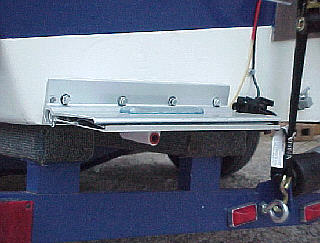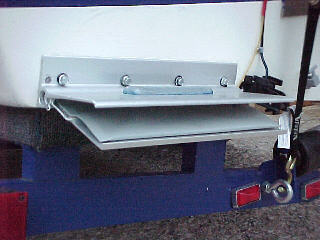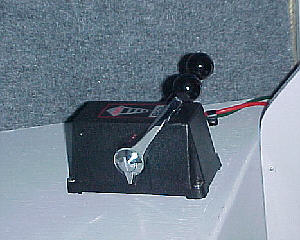|
More impressions of the Cabin Skiff 10/6/00 I now have spent considerable time in my Cabin Skiff. The trip meter is showing over 1000 miles since the maiden voyage on July 22, 2000. I have most of the bugs worked out and am enjoying just cruising around. I am convinced that the majority of my problems (and initial disappointment) were caused by the construction error in the aft section of the hull bottom that allowed the last 12 inches to taper upward about 1/4 to 3/8 inch. This made the boat ride bow high and reduced overall performance. In addition to that I also feel the CS ended up heavier than it should have been and this too contributed to the problem. So what have I done to remedy the situation? I first tried an easy fix – I bolted a Stingray planing wing to the lower unit. This did help. I could bring the bow down and eliminate the porpoising. But handling was a little squirrelly. Not bad just a little strange. At cruise speed and properly trimmed the bow seemed to “wander”. It just kind of floated from sided to side. I am not sure why but my guess is that there was so little keel in the water that directional control was diminished. Again it wasn’t scary just annoying. I could trim down but then the loss of speed at a give RPM was quite noticeable. Yes, better but not right.
He said he had picked up a couple of sets of these from a local company that was no longer marketing them. The brand name on the box was “Accu Trim.” The looked like normal trim tabs (minus the hydraulic cylinders) with the exception of a small tube like projection in the bottom that points into the water flow.
Would they really work? Good question! Looking at them though I realized that if worst came to worst I could convert them to fixed tabs. Since I figured it would cost me about $75 for all the stainless steel material to build my own, my gamble was only about $25 if they didn’t work. And if they did I had cockpit control which would be nice.
There were also a couple of added benefits. First, I have found that if I put the tabs all the way down I can cruise along with the hull level in the water at 11 or 12 MPH. I wouldn’t think it is actually on plane at that speed but the speed does increase with no throttle adjustment when the bow is forced down. Also it has greatly improved the rough water ride. The CS has a V bottom but with 12 degrees at the transom it is still fairly flat. I also need to describe what I call rough water. You have to remember I am an inland boater – lakes and rivers. A 12 to15 MPH wind usually produces white caps and that is a rough as I like to encounter at speed (20 to 25 mph). With this kind of water the CS can be a rough ride that tires you quickly. The only fix was to bring it off plane and plow a lot of water or slow to a crawl. Now if I slow to about 18 MPH and use the tabs to force the bow down I can get a comfortable ride and still yield decent fuel economy. Neat! The trim tabs have made a big difference. The CS is now handling much more like I thought it should and has greatly increased my satisfaction with the project. BUT there is still a little voice whispering in the back of my mind – “Yea, it’s a fix but a dirty fix.” The ultimate fix is to crawl under the boat and build up the bottom to where it is level. I really want to do this. I know it would be a real pain to lay on my back under the CS and add the necessary wood, then sand, then glass. But unless that is done I still feel I have an area of drag created by the upward taper. I would be willing to do it but for one very important fact – EPOXY! I am finally just about fully healed from the allergic reaction. I really hate to put my body through that again. Plus I am really not sure how much gain there would be. What if I went to all the work and epoxy reactions just to find minimal improvement? I was discussing this via email with someone that had questions about
the project and he made an excellent suggestion. He offered that
an acceptable fix might be to add “wedges” to the bottom of the hull.
He stated that he added these to his project after seeing them on several
boats. The idea is to make a wedged shaped piece of wood and simply
glue it to the bottom of the hull. He suggested experimenting with
a wedge about 10” wide and 8” long tapering from 3/8 to nothing.
He said just to tape these to the bottom of the hull and see what happens.
He added that the first set he made for his added too much bow down so
the had to thin them down. Once the correct size is found then cover
them with glass (I could use polyester resin for this) and then epoxy them
to the bottom. NO, this is a perfect fix but much easier than actually
trying to reshape the hull and I would think it would help eliminate my
built-in drag while lifting. I may well give this a try once it gets
colder. Right now I am having too much fun exploring every body of
water I can find.
|
 I
decided that trim tabs were in my future. I priced factory made units
that were controllable from the cockpit and found that they started about
$350 and went up from there. I really didn’t want to spend that much
money on a fix when I really wasn’t sure it would do what I needed it to
do. I was ready to make a “fixed” pair of tabs when I ran onto a
classified ad for a new set of trim tabs still in the box for $100.
I called to find out what they were. The guy explained that they
weren’t hydraulic or electric but they were cockpit controllable.
I was confused with his explanation so I decide to go take a look.
I
decided that trim tabs were in my future. I priced factory made units
that were controllable from the cockpit and found that they started about
$350 and went up from there. I really didn’t want to spend that much
money on a fix when I really wasn’t sure it would do what I needed it to
do. I was ready to make a “fixed” pair of tabs when I ran onto a
classified ad for a new set of trim tabs still in the box for $100.
I called to find out what they were. The guy explained that they
weren’t hydraulic or electric but they were cockpit controllable.
I was confused with his explanation so I decide to go take a look.
 Actually
each tab is a to piece affair. The top section is mounted to the
transom and is fixed. The bottom plate is hinged and drops down to
activate. The principal is that water flows in to the tube and up
into a bladder between the two pieces. This forces the bottom one
down for the trim action. The amount of activation is controlled
from the cockpit with dual levers mounted on a small box. Pushing
a lever down sends a small amount of air down to the tube. Here there
is a small balloon like device that blocks off the tube forcing the water
up into the bladder. The larger you make the balloon the more it
blocks the tube which yields more trim action. Reduce the size and
the amount of trim is reduced. When the balloon is fully retracted
the water just passes through the tube and no trim activation is created.
Actually
each tab is a to piece affair. The top section is mounted to the
transom and is fixed. The bottom plate is hinged and drops down to
activate. The principal is that water flows in to the tube and up
into a bladder between the two pieces. This forces the bottom one
down for the trim action. The amount of activation is controlled
from the cockpit with dual levers mounted on a small box. Pushing
a lever down sends a small amount of air down to the tube. Here there
is a small balloon like device that blocks off the tube forcing the water
up into the bladder. The larger you make the balloon the more it
blocks the tube which yields more trim action. Reduce the size and
the amount of trim is reduced. When the balloon is fully retracted
the water just passes through the tube and no trim activation is created.
 I
mounted the tabs on the transom as per instructions and removed the planing
wing from the lower unit. I then dropped the CS in the river for
a test. I noticed an immediate difference. Even with no activation
the bow rode lower than it did with the planing wing. Still had a
slight tendency to porpoise. This puzzles me because the bow IS noticeably
lower than with the wing. Adding in a little trim tab cleans up the
porpoising. Speeds look good – no change at given RPMs. In
addition I note that the ride is better in the small waves created by the
5 to 8 MPH wind. The tendency for the bow to wander is also almost
completely gone.
I
mounted the tabs on the transom as per instructions and removed the planing
wing from the lower unit. I then dropped the CS in the river for
a test. I noticed an immediate difference. Even with no activation
the bow rode lower than it did with the planing wing. Still had a
slight tendency to porpoise. This puzzles me because the bow IS noticeably
lower than with the wing. Adding in a little trim tab cleans up the
porpoising. Speeds look good – no change at given RPMs. In
addition I note that the ride is better in the small waves created by the
5 to 8 MPH wind. The tendency for the bow to wander is also almost
completely gone.